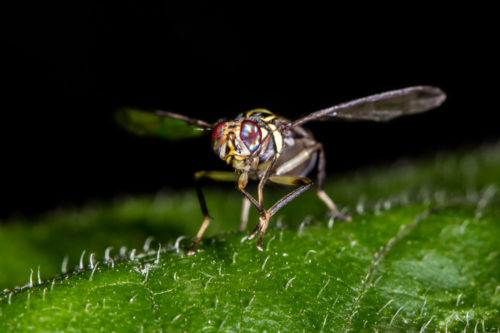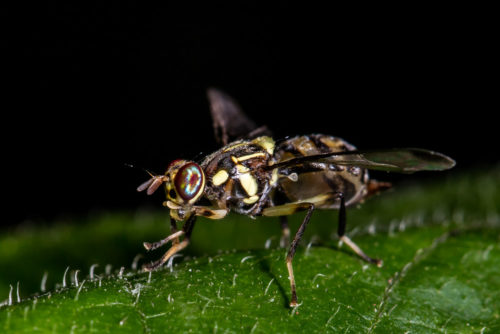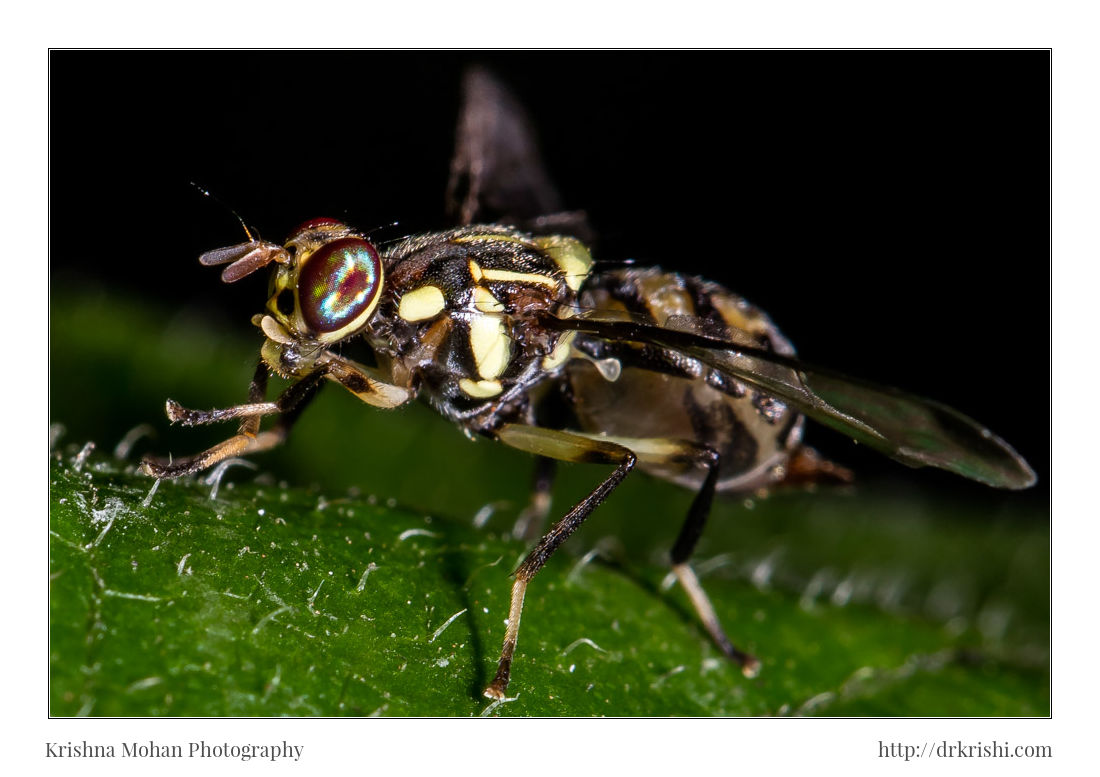
I found this Oriental Fruit Fly jumping around on a leaf in my backyard. I used Canon EOS 5DS R with Canon EF 100mm f/2.8L Macro IS USM lens. This was illuminated by Godox Ving V860c E-TTL Li-ion Camera with LumiQuest SoftBox III to capture this beauty.
Oriental Fruit Fly belongs to Bactrocera genus, which is a large genus of tephritid fruit flies, with more than 500 species currently described. Bactrocera forms part of a species complex, within which over 50 species have been described in Asia. Bactrocera occurs on a wide range of fruit crops, for example in China and Japan on Sugar-apple (Annona squamosa), apples (Malus pumila), Star Fruit (Averrhoa carambola), bananas (Musa paradisiaca), Capsicum (Clausena lansium), guavas (Psidium guajava), mangoes (Mangifera indica), oranges (Citrus sinensis), papaya (Carica papaya), peaches (Prunus persica), plums (Prunus domestica), Pyrus spp. and tomatoes (Lycopersicon esculentum). It is considered as one of the five most important pests of agriculture in South East Asia. Due to confusion between Bactrocera and related species in South East Asia, some published host data may concern other species within the Bactrocera species complex.

They have mostly been found on hosts such as mangoes, guavas and pawpaws, and in general seem likely to be polyphagous like Bactrocera. B. carambolae occurs especially on Star fruit and Rose Aplle (Syzygium samarangense) in South America. The wild hosts of Bactrocera and its sister species are not well documented.
Bactrocera as now described occurs in the Northern Hemisphere (with the marginal exception of Nauru). The other species occur in the south of the Indian subcontinent and in South East Asia. North America: Outbreaks in USA (California, Florida), eradicated in 1987, but found again in California in 1989. Reported in Hawaii since about 1945. Oceania: Guam since 1947, Nauru. An outbreak on Northern Mariana Islands (Rota) was eradicated. It is absent from the European Union.

Eggs of Bactrocera are laid below the skin of the host fruit. These hatch within 1-3 days and the larvae feed for another 9-35 days. Bactrocera will not develop at temperatures below 13°C. Pupariation is in the soil under the host plant and Adults emerge after 1-2 weeks (longer in cool conditions) and adults occur throughout the year. Attacked fruit will usually show signs of oviposition punctures. Fruit with a high sugar content, such as peaches, will exude a sugary liquid, which usually solidifies adjacent to the oviposition site.
Bactrocera is a serious pest of a wide variety of unrelated fruit crops. It is considered as one of the five most important pests of agriculture in South East Asia. Published data on its importance applies over all the Asian range of the Bactrocera complex, including areas where Bactrocera is not now considered to occur. On this basis, at least the more widely distributed of the other pest species of the complex (B. carambolae, B. papayae) are probably as damaging.

When detected, it is important to gather all fallen and infested host fruits and destroy them. Insecticidal protection is possible by using a cover spray or a bait spray. Malathion is the usual choice of insecticide for fruit fly control and this is usually combined with protein hydrolysate to form a bait spray.
I had misidentified this fly as Soldier Fly. Thanks to Yeshwanth HM for correcting me, so I am rewriting the whole blog again.

